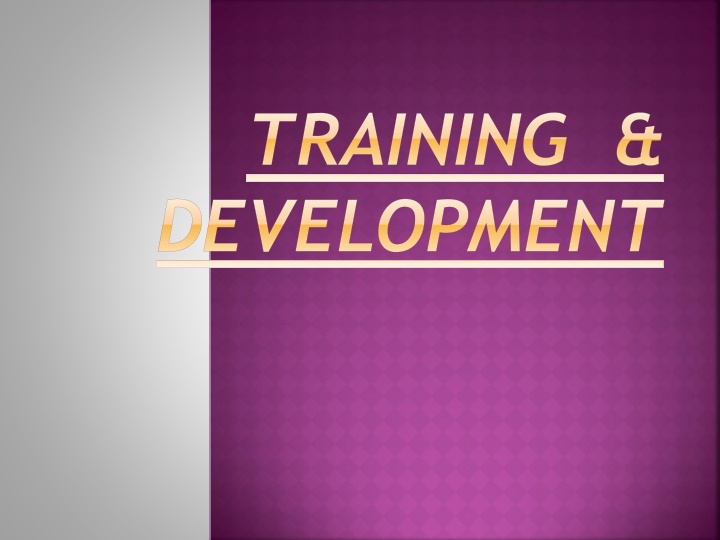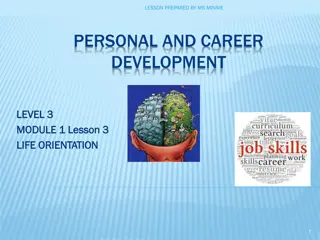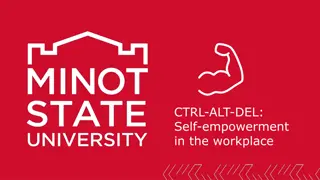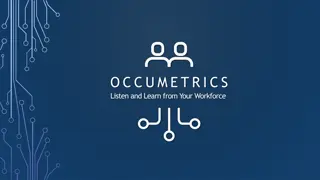Comprehensive Guide to Training and Development in the Workplace
Training and development are essential for enhancing employee skills and knowledge. This process aims to prepare employees for their current roles or future responsibilities through induction, skill acquisition, and continuous learning. Addressing the training needs of employees at different career stages, conducting thorough analyses, setting objectives, and considering organizational aspects are vital steps in designing effective training programs.
Download Presentation

Please find below an Image/Link to download the presentation.
The content on the website is provided AS IS for your information and personal use only. It may not be sold, licensed, or shared on other websites without obtaining consent from the author.If you encounter any issues during the download, it is possible that the publisher has removed the file from their server.
You are allowed to download the files provided on this website for personal or commercial use, subject to the condition that they are used lawfully. All files are the property of their respective owners.
The content on the website is provided AS IS for your information and personal use only. It may not be sold, licensed, or shared on other websites without obtaining consent from the author.
E N D
Presentation Transcript
TRAINING & DEVELOPMENT
MEANING The act of increasing the knowledge and skills of an employee for doing a particular Job. Process that tries to improve skills or add to the existing level of knowledge so that the employee is better equipped to do his present job, or to mould him to be fit for a higher job involving higher responsibilities.
NEED All employees have training needs at different stages in their career. Four Basic needs : 1. Company & product induction for new recruits. 2. Acquisition of basic job skills 3. Development of new or further upgrading knowledge, skills & attitudes. 4. Assistance in adjusting to retirement or redundancy.
STEPS IN CONDUCTING TRAINING PROG. 1. Training Need Analysis (TNA) : Gap between what is currently in place and what is needed at present and in future Organisational Analysis Task Analysis Man / Individual Analysis
ORGANISATION ANALYSIS Environmental impact State of economy & impact on operating cost Changing workforce demographics & need to address cultural or language barriers Changing technology & automation Increasing global market places Political trends Organisational goals, resource availability Climate & support for training, employee willingness to participate
TASK ANALYSIS Job description KSA Analysis Performance standards
MAN ANALYSIS Performance evaluation Performance problems Observation Questionnaires Attitude Survey Checklist or training progress charts
2. Setting Training Objectives : To impart induction to new employees the basic knowledge and skills required for efficient performance of the particular task To help the employees function more effectively in their present positions by updating them the latest concepts information, techniques and developing the skills they would require in their particular field of activity. To prepare second line of personnel To develop competency among employees in newer areas like creativity, innovativeness etc.
3. DESIGNING TRAINING METHOD On the job Training Off the job Training
ON THE JOB TRAINING : Job Instruction Training (JIT) Coaching Mentoring Job Rotation Apprenticeship Training Committee Assignments
OFF THE JOB TRAINING : Case Study Method In Basket Exercise Management Games Vestibule training. Role Playing. Lecture Method. Conference / Discussion approach Programmed instructions.
4. ADMINISTRATION OF TRAINING PROG. Training Content Training Location Trainer Training Budget / Detailed costing Lead Time
5. EVALUATION OF TRAINING PROG. Evaluation of Training Aspects Assessment of Training Utility Reaction of participants Learning Behaviour Result
RECENT TRENDS Infosys plans to increase its training budget by 24% next year to $230 million and has already hiked training time from 10 weeks to 29 weeks. The head HR & Director Mr. Mohandas Pai said that Infosys plans to reward employees by offering more leadership positions.
Indian organizations on average spent US $331 per employee on training and development in 2011, according to a study on learning and development trends in India, by the American Society for Training & Development (ASTD) and Harvard Business Publishing (HBP).
Consulting companies like Deloitte and PwC say that currently, Indian IT and ITeS companies spend between 3-3.5 per cent of their payroll costs in training talent.























